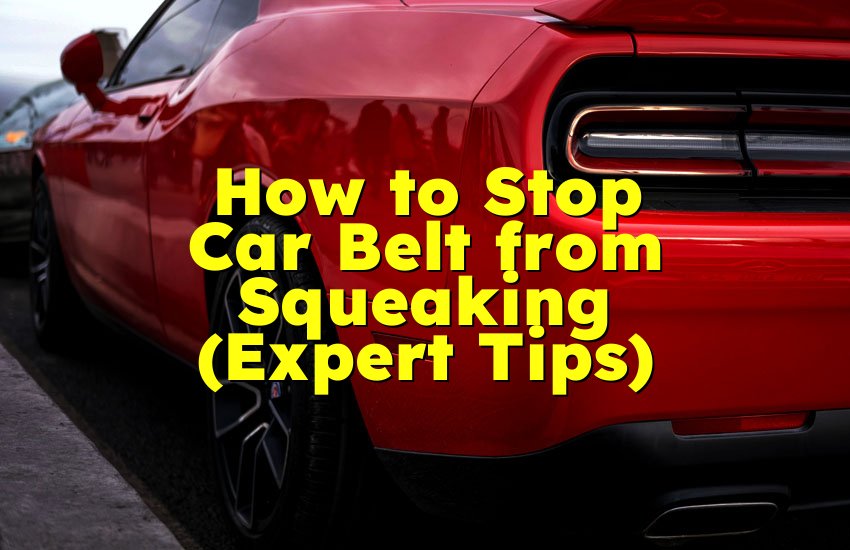As an Amazon Associate, I earn from qualifying purchases at no extra cost to you.
How to Stop Car Belt from Squeaking (Expert Tips)
If your car belt squeaks, the quick answer is simple: check the belt for wear, adjust its tension, and clean or replace it if needed. A squeaky belt is usually loose, worn, or dirty. Fixing it quickly will stop the noise and protect your engine from damage. In this article, you will learn step by step how to stop car belt from squeaking, what causes it, and how to keep it quiet for good.
Find Out Why the Car Belt Makes Noise
A squeaky car belt is not just annoying. It is often a warning that something is wrong under the hood. The most common reason is that the belt is too loose or too tight. When the tension is off, the belt slips on the pulleys and makes a squeaking sound. Dirt, oil, or water on the belt can also cause noise. Sometimes, the belt itself is worn out and needs to be replaced.
It is very important to look for the root cause. If you only spray something on the belt to quiet it, the noise will soon come back. Even worse, ignoring the cause can lead to belt breakage. When a belt breaks, the alternator, water pump, or power steering can stop working. That can leave you stranded. So always treat squeaks as a real problem, not just an annoying sound.
To check the cause, first look at the belt closely. If you see cracks, shiny spots, or frayed edges, it is worn out. If the belt looks fine, push down on it with your finger. It should move a little but not too much. If it moves too easily, it is too loose. If it feels stiff and too tight, that is also bad. You should also look at the pulleys. A bent or dirty pulley can also make noise.
Once you know why the belt is squeaking, you can fix it in the right way. Always remember that guessing will waste time. It is better to spend a few minutes finding the real reason first. Then the solution will last longer, and the car will run smoothly.
- Look for loose or tight belt tension
- Check for cracks, wear, or shiny spots
- Inspect pulleys for dirt or damage
- Watch out for oil or water on the belt
Clean the Car Belt and Pulleys
Dirt and oil are common reasons why a belt makes noise. Even a small amount can cause slipping and squeaks. Cleaning is often the easiest way to stop the sound without spending money right away. Many times, people replace a belt when a simple cleaning would have solved the issue. That is why you should always try cleaning first.
To clean the belt, use a clean dry cloth and wipe the surface well. Do not use strong chemicals because they can damage the rubber. If there is oil or grease, you can use a small amount of mild soap and water, but be sure to dry the belt fully after. Moisture left on the belt can also cause squeaking. A dry, clean belt will grip the pulleys better and stay quiet.
Cleaning the pulleys is just as important. Dirt or rust on a pulley can create a squeak even if the belt is fine. Use a brush or cloth to clean each pulley surface. Make sure the pulleys spin smoothly without wobbling. If a pulley is bent or does not spin right, the belt will slip and squeak. In that case, the pulley needs to be repaired or replaced.
After cleaning, listen to the car while it runs. If the squeak is gone, you know the problem was dirt or oil. If the squeak comes back soon, then cleaning was not enough, and the belt may be worn or the tension is wrong. But cleaning first is always a smart step because it is safe, quick, and free.
- Wipe belt with dry cloth
- Remove oil, grease, or water
- Clean pulleys and check spin
- Dry belt fully before running car
Adjust the Belt Tension
Even if the belt looks clean and new, it will squeak if the tension is wrong. A belt that is too loose slips on the pulleys. A belt that is too tight makes a high-pitched squeal and can wear out parts. Adjusting the tension is one of the most effective ways to stop car belt squeaks.
To check tension, press down on the belt at its longest point. A healthy belt should move about half an inch to one inch. If it moves much more, it is too loose. If it barely moves, it is too tight. The right tension lets the belt grip without putting too much stress on the parts.
Adjusting tension depends on the type of belt. Many older cars have a manual adjustment. You loosen a bolt on the alternator or power steering pump, move it to adjust tension, and tighten it again. Newer cars often have an automatic tensioner. If that part fails, the belt will squeak even if the belt is new. In that case, the tensioner itself must be replaced.
It is always better to adjust carefully. Never over-tighten because that puts stress on bearings and pulleys. A belt that is too tight can damage the alternator, water pump, or power steering pump. Always check twice to make sure the tension feels right. A balanced belt runs smooth, stays quiet, and lasts longer.
- Belt should move half inch to one inch
- Loosen or tighten by moving parts
- Check for faulty automatic tensioner
- Avoid over-tightening belt

Replace a Worn or Damaged Belt
Sometimes, no matter how much you clean or adjust, the belt keeps squeaking. That is a clear sign the belt itself is worn or damaged. Rubber belts do not last forever. Heat, friction, and age all wear them down. If you see cracks, frayed edges, or shiny glazed spots, then it is time for a replacement.
Replacing a belt may sound hard, but it is usually a simple task. First, you need the right belt for your car. Check your manual or ask at an auto parts store. Each belt has a specific size and shape that fits your car’s pulleys. Using the wrong belt will cause more noise and even damage.
When you remove the old belt, note how it runs around the pulleys. Many cars have a diagram under the hood showing the correct path. If not, draw your own before removing it. Then loosen the tension, slide the old belt off, and put the new one on. Make sure it sits evenly on all pulleys.
After installing, check the tension again. Start the car and listen. A new belt that is installed correctly should run smooth and quiet. If there is still squeaking, then the issue is not just the belt. You may need to check the pulleys or tensioner again. But most of the time, a fresh belt solves the noise.
- Replace if cracks or fraying appear
- Use the correct size for your car
- Follow pulley diagram for install
- Check tension after fitting new belt
Lubricate with Care if Needed
Many people think spraying something on the belt will stop squeaks. Sometimes it works for a short time, but it is not a real fix. Some sprays can damage rubber and make the problem worse. However, in some cases, a light application of belt dressing can help. It can give the belt better grip on the pulleys.
If you decide to use a dressing, always read the label first. Use only products that are safe for rubber belts. Spray lightly and evenly while the engine is running. Do not over-spray because too much can attract dirt and create new squeaks later. Also, never use oils, greases, or random sprays from your garage. They can ruin the belt fast.
Belt dressing is best used as a temporary fix. For example, if your belt squeaks while you are away from home, it can quiet it until you get a proper repair. It should never be your main solution. Cleaning, adjusting, or replacing the belt is always the better choice.
Using dressing with care can sometimes extend the belt life for a while. But remember, if a belt is old or worn, sprays will not save it. The sound will return, and the belt will fail soon. So only use dressing when needed and treat it as a short-term helper.
- Only use rubber-safe sprays
- Apply lightly and evenly
- Avoid oils or greases
- Treat dressing as temporary help
Keep Belts in Good Shape with Maintenance
The best way to avoid squeaks is to keep your belts healthy. Regular checks and maintenance will save you time and money later. Belts usually last 50,000 to 100,000 miles, but wear can come sooner. Hot weather, leaks, or poor tension can shorten their life. Checking often helps you catch issues early.
Make it a habit to inspect the belts every few months. Look for cracks, frays, or shiny spots. Check the tension by pressing on the belt. Listen for any noise when you start the car. A small squeak today can become a big repair tomorrow if ignored.
Also, check for leaks in your engine. Oil or coolant dripping onto the belt will damage it fast. Fixing leaks quickly not only helps the belt but also protects your whole engine. Clean pulleys and belt surfaces when you can. A clean system runs smoother and quieter.
Finally, replace belts at the right time. Even if they look fine, old belts can fail without warning. Changing them on schedule is much safer than waiting for a breakdown. A little care and attention will keep your car quiet, safe, and reliable for years.
- Inspect belts every few months
- Watch for oil or coolant leaks
- Clean pulleys regularly
- Replace belts at schedule miles
Final Thoughts
A squeaky belt can be annoying, but it is also a warning sign. By checking tension, cleaning, or replacing the belt, you can stop the noise and avoid bigger problems. Regular care keeps the car running smoothly and quietly.
| Action | Purpose | Result |
|---|---|---|
| Inspect belt | Find wear or damage | Know when to replace |
| Clean belt and pulleys | Remove dirt and oil | Reduce squeaks |
| Adjust tension | Correct grip | Stop slipping noise |
| Replace belt | Fix worn parts | Quiet and safe drive |
| Use belt dressing | Short-term quiet | Temporary relief |
| Maintain regularly | Prevent issues | Long-lasting smooth belt |
Frequently Asked Questions (FAQs)
Is it dangerous to drive with a squeaky belt?
Yes, it can be dangerous to drive with a squeaky belt. The squeak means the belt is slipping or wearing out. If the belt breaks, important systems like the alternator, water pump, or power steering can stop working. That can leave you stuck on the road or even damage your engine. It is always best to fix the noise quickly instead of waiting for the belt to fail.
Can a squeaky belt damage my car?
Yes, a squeaky belt can damage your car if ignored. The squeak often means the belt is slipping, which can wear out pulleys and bearings. It also puts stress on parts like the alternator and power steering pump. Over time, this damage becomes costly. Fixing the belt early is much cheaper than repairing those parts later. Always take belt noise seriously before it leads to bigger issues.
Do I need special tools to adjust a car belt?
In many cars, you can adjust the belt with basic hand tools like a wrench or socket. For older cars, you may need to loosen bolts and move the alternator or another part. Some cars use an automatic tensioner, which may require a special tool to release tension safely. Always check your car’s manual before starting. Most adjustments are simple, but safety comes first when working near moving parts.
Is it better to replace or clean a squeaky belt?
It depends on the condition of the belt. If the belt is new but dirty or oily, cleaning often solves the noise. However, if the belt shows cracks, frays, or glazed spots, replacing is the smarter choice. Cleaning can only do so much. Old rubber will keep squeaking no matter how clean it is. Replacing ensures a quiet ride and avoids sudden failure on the road.
Can I spray WD-40 on a squeaky belt?
No, you should never spray WD-40 or similar oils on a car belt. Oils can damage the rubber and cause it to slip more, which makes the squeak worse. They can also attract dirt, leading to faster wear. Only use sprays that are made for belts, called belt dressings, and even then, only as a short-term fix. For a lasting solution, clean, adjust, or replace the belt.
Do I need to replace pulleys with the belt?
Not always. If the pulleys are clean, smooth, and spin well, you only need to replace the belt. But if the pulleys are rusty, bent, or wobbling, they must be fixed or replaced too. A new belt will not last long on bad pulleys. Always inspect both the belt and pulleys together. This way, you avoid future squeaks and keep your car running strong.
Is it normal for a new belt to squeak?
Sometimes a new belt can squeak for a short time after installation. It may need to settle or be adjusted for proper tension. If the noise continues after a few days, then something is wrong. The tension may not be set right, or a pulley may be dirty or worn. New belts should run quiet once they are installed correctly. Long squeaks are not normal.
Can weather cause my car belt to squeak?
Yes, weather can affect your car belt. Cold mornings often make belts squeak because the rubber stiffens. Rain or moisture can also cause slipping and noise. Usually, the sound fades as the car warms up. However, if squeaks continue even in warm dry weather, then the belt or pulleys likely need attention. Weather can trigger squeaks, but it is not the only cause to watch for.











